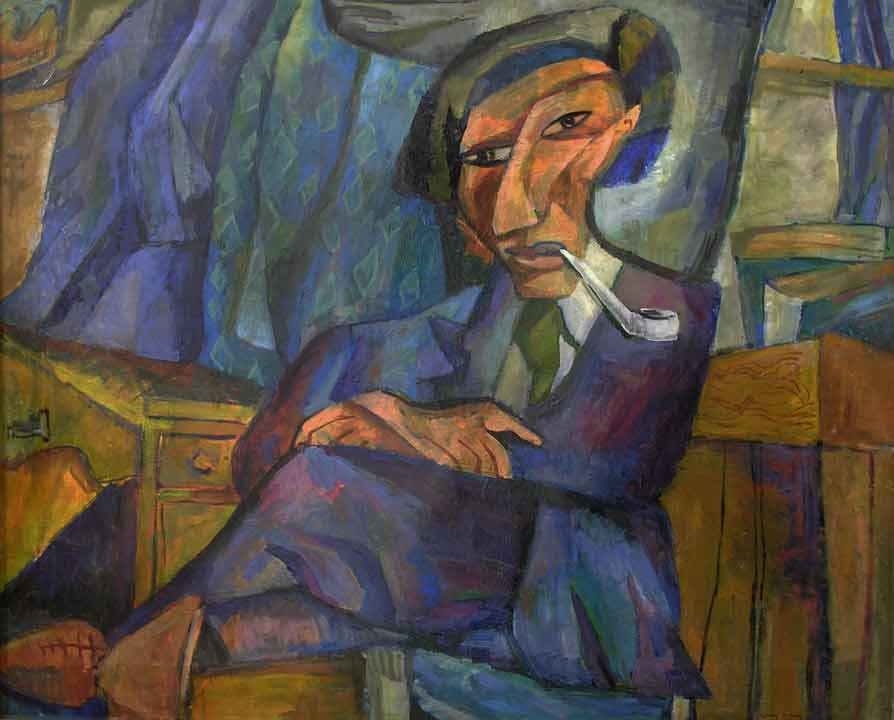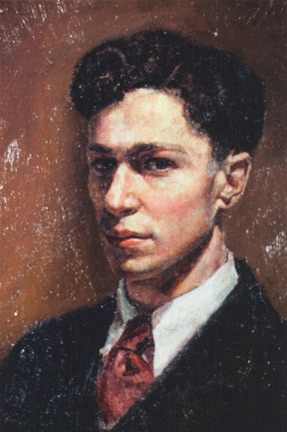

HANANIAH HARARI
"SELF PORTRAIT"
OIL ON CANVAS, SIGNED IN HEBREW
AMERICAN, PAINTED IN PARIS C.1935
23 X 28 INCHES

SELF PORTRAIT 1931
Hananiah Harari Hananiah Haraari, the celebrated American painter and illustrator, was born on August 29, 1912 in Rochester, NY. Harari studied first at the Rochester Memorial Art Gallery, and then from 1930-32 at Syracuse University School of Fine Arts. Harari then traveled to France, where he studied under André Lhote, Fernand Léger and Marcel Gromaire. Through portrait commissions Harari was able to extend his stay on the city's Left Bank for several years. In Paris, Harari sought out Impressionist and Old Master paintings as well as modern works. He spent a year doing copy drawings from the collections of the Louvre. Following a visit to Palestine in 1935, Harari returned to the United States, settling in New York City. He was active in leftist politics, and helped found the American Artists' Union in 1936. In the late 1930's, Harari joined the circle of young abstractionists working on the Works Progress Administration's mural project under Burgoyne Diller. He co-founded the American Abstract Artists. Harari learned a range of engraving techniques at the WPA, silk printing in particular. In 1941, he won the National Academy of Design award. He worked in both a semi-abstract style, and a precise realist style; inspired by the work of William Michael Harnett, he painted many trompe l'oeil still lifes. Harari executed some striking pieces in the spirit of 'modern' painters, such as Picasso, but his work, commissioned by private business or advertising companies, answers to a variety of styles, and was never lacking in humor. Harari would have accepted the label of realist or magic realist-or of the latter-day Pre-Raphaelite. Never a doctrinaire abstractionist, even in the early years of his career, he moved freely between abstraction and a lyrical expressionism that incorporated figurative elements. Harari was unwilling to relinquish the rich possibilities the natural world offered. Moreover, the strict avoidance of recognizable forms precluded expression of Harari's irrepressible wit. Social and political concerns, and a desire to educate those unfamiliar with modern art, characterize Harari's philosophy about art's significance and potential. Several paintings from the late 1930s and early 1940s reflect his horror at the political oppression and social atrocities taking place in Germany. In 1943 Harari was inducted into the army, and at that time he ended his association with the American Abstract Artists. An active, early member of the group, Harari's artistic interests after the war no longer coincided with the group's program. In the 1940s he produced artwork for the covers of magazines, including Fortune. He also contributed cartoons to The New Masses, which led to his being blacklisted in the 1950s during the McCarthy era. Harari had his first solo show in France in 1933, at the American Club in Paris. His first New York show exhibition took place in at Mercury Gallery, in 1939. In 1997, he was the subject of career restrospectives at the Montclair Art Museum in New Jersey, the Neuberger Museum of Art in Purchase, NY and the Dai Ichi Arts in Manhattan. Another retrospective was organized by the Memorial Arts Gallery in Rochester, NY in 1998. Harari taught at the School of Visual Arts in Manhattan from 1974-1990, and at the Art Students League from 1984-1999. Harari's works can be found in the collections of many major museums including: the Metropolitan Museum of Fine Arts, the Whitney Museum of American Art, the Smithsonian, the Boston Museum of Fine Arts, The Philadephia Museum of Art, the Yale University Art Gallery and The Amon Carter Museum (Fort Worth, TX), The British Museum, and the Brooklyn Museum. He died in Halthorne, New York in 2000. |